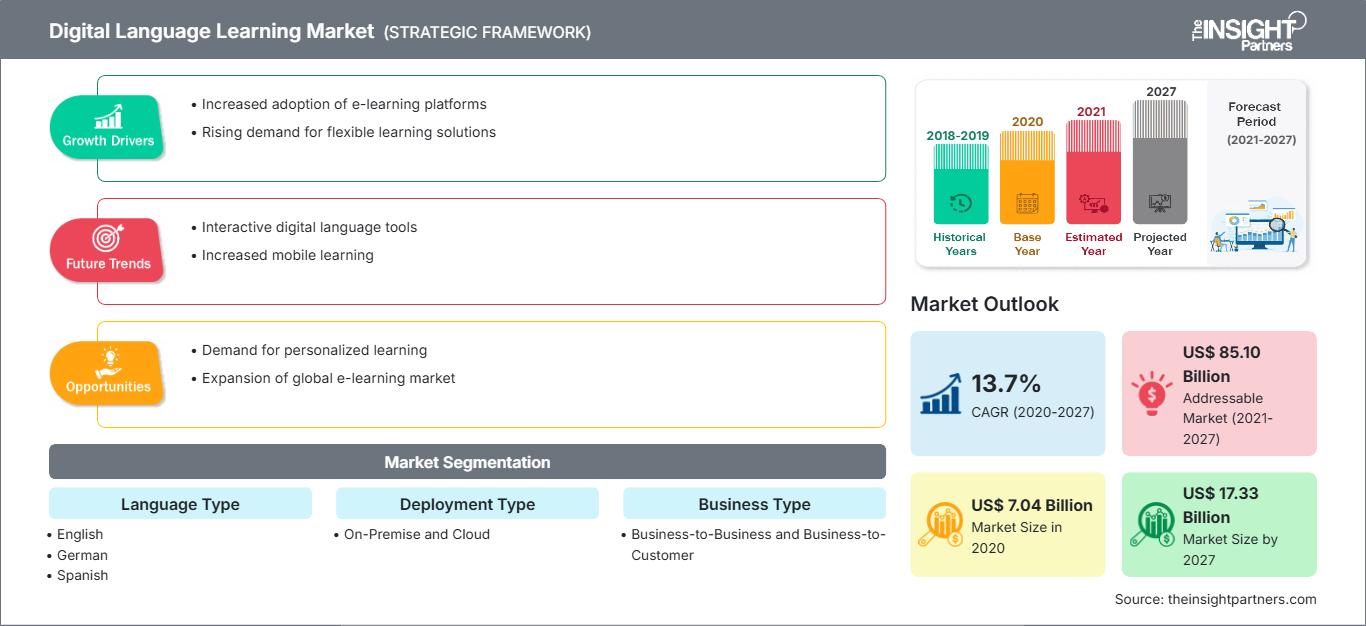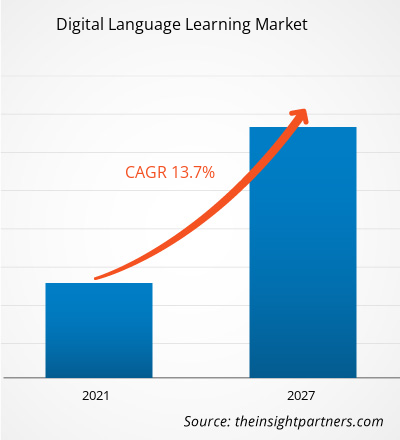デジタル言語学習市場は、2020年の70億3,820万米ドルから2027年には173億3,340万米ドルに成長すると予想されており、2020年から2027年にかけて13.7%のCAGRで成長すると予測されています。
各国政府による英語学習プログラム実施の取り組みが、市場の成長を後押ししています。世界の教育分野は、政府や民間組織がデジタル強化のパフォーマンスを提供するために行っているさまざまな取り組みを背景に、飛躍的に変化しています。中国、オーストラリア、ブラジル、UAEなど、さまざまな国の政府が過去数年間にデジタル教育スキームを開始し、これらの国々の英語教育システムの強化に役立っています。たとえば、10年前に開始されたオーストラリア政府によるデジタル教育革命(DER)により、多くの学校や大学がデジタル教育を活用できるようになりました。同様に、中国政府も英語学習に重点を置いたデジタル教育を推進するための政策をいくつか開始しており、中国の学生にデジタル学習ソリューションを提供する企業の数が増加しています。51Talkは中国で最も著名なデジタル英語学習機関の一つです。17Zuoyeは、中国の学生、教師、保護者向けのデジタルプラットフォームで、演習や宿題の形でオンライン課題を提供することで、エンドユーザーの能力向上を支援しています。現在、インドはデジタル教育のための大きな市場空間を創出しようと躍進しています。インド政府は、教育分野におけるデジタル化技術の普及に向けて、様々な取り組みを行っています。SWAYAMは、インド政府が主導する最も著名なデジタル学習プラットフォームであり、学生が高等教育のあらゆる科目を網羅したオンラインコースを選択できるように支援しています。海外の大学もSWAYAMプラットフォームを通じてそれぞれのコースと試験を提供できるようになっており、学生は海外の大学で学び、試験を受けることができます。こうした要素により、学生の英語学習、スピーキング、ライティングのスキルが向上します。国立デジタル図書館は、インド政府がワンストップで仮想的な学習リソースを提供するというビジョンを掲げて実施しているもう一つの取り組みです。この取り組みは徐々に注目を集めており、今後数年間でインドのデジタル英語学習市場の成長を後押しし、ひいては世界のデジタル言語学習市場の成長にも貢献すると期待されています。
要件に合わせてレポートをカスタマイズ
レポートの一部、国レベルの分析、Excelデータパックなどを含め、スタートアップ&大学向けに特別オファーや割引もご利用いただけます(無償)
デジタル言語学習市場: 戦略的洞察

-
このレポートの主要な市場動向を入手してください。この無料サンプルには、市場動向から見積もりや予測に至るまでのデータ分析が含まれます。
最近のパンデミックの発生は、過去数ヶ月間に世界中の既存の教育セクターにかなりのプラスの混乱をもたらしました。さらに、従来の教育機関や教室での学習手法の混乱により、堅牢で効率的なオンラインおよびデジタル学習ソリューションの採用が急増し、今後数年間はパンデミック後も市場の成長を牽引し続けると予測されています。たとえば、ユネスコは、テクノロジー企業やITU(国際電気通信連合)の主要な代表者数名と協力して、新興経済国において物理的なインフラに多額の投資をすることなく、より多くの人が迅速な学習能力を身に付けられるよう、学習にデジタル技術を採用することの経済的意義を強調しました。一方、ケンブリッジ大学が実施した別の調査では、1,200人を超える回答者が、今後数年間で調査対象者の60%がデジタル学習技術を継続する傾向が高まっていることを認識しました。したがって、最近の発生により、デジタル学習テクノロジーの採用が急増し、その後、過去数か月間の市場成長にプラスの影響を与えています
市場洞察 - デジタル言語学習市場:高度で簡素化されたテクノロジーを活用して学生をデジタル教育に引き付ける
米国や英国などの先進国では、学校、大学、その他の教育機関の学生がテクノロジーを完全に認識しているため、デジタル教育システムは非常に人気が高まっています。ただし、APACおよびSAM諸国では、学生はテクノロジー主導の学習を認識していません。多くの学校、大学、コーチング機関が授業にデジタルテクノロジーを導入しています。デジタル教育プラットフォームの開発者は、堅牢なソリューションを提供するためにテクノロジーを常にアップグレードしているため、APACの導入者はテクノロジーインフラストラクチャを継続的にアップグレードしています。革新的なクラウドベースの教育アプリ、ウェブサイト、その他のサービスは、デジタル言語学習ソリューションを含むデジタル教育の大きな市場を創出すると期待されています。
言語種別に基づく洞察
言語種別に基づいて、デジタル言語学習市場は英語、中国語、スペイン語、ドイツ語、その他に分類されます。2019年には英語セグメントが最大の市場シェアを占めました。デジタル言語学習市場の地域別分析
予測期間を通じてデジタル言語学習市場に影響を与える地域的なトレンドと要因については、The Insight Partnersのアナリストが詳細に解説しています。このセクションでは、北米、ヨーロッパ、アジア太平洋、中東・アフリカ、中南米におけるデジタル言語学習市場のセグメントと地域についても解説しています。
デジタル言語学習市場レポートの範囲
| レポート属性 | 詳細 |
|---|---|
| の市場規模 2020 | US$ 7.04 Billion |
| 市場規模別 2027 | US$ 17.33 Billion |
| 世界的なCAGR (2020 - 2027) | 13.7% |
| 過去データ | 2018-2019 |
| 予測期間 | 2021-2027 |
| 対象セグメント |
By 言語タイプ
|
| 対象地域と国 |
北米
|
| 市場リーダーと主要企業の概要 |
|
デジタル言語学習市場のプレーヤー密度:ビジネスダイナミクスへの影響を理解する
デジタル言語学習市場は、消費者の嗜好の変化、技術の進歩、製品メリットへの認知度の高まりといった要因によるエンドユーザーの需要増加に牽引され、急速に成長しています。需要が高まるにつれ、企業は提供内容を拡大し、消費者ニーズを満たすための革新を進め、新たなトレンドを捉えることで、市場の成長をさらに加速させています。

- 入手 デジタル言語学習市場 主要プレーヤーの概要
デジタル語学学習市場で活動している企業は、高度で効率的な製品の開発に主に焦点を当てています。
- 2019年、Fluenzは、2020年春にスペインのバルセロナにスペインの高級イマージョンプログラムを拡大すると発表しました。ユーザーは、語学学習のために6日間プログラムに参加できるようになります。
- 2018年、Preply, Inc.は、2019年初頭にバルセロナに新しいオフィスを開設する計画を発表しました。この拡大は、7月に400万ドルの資金調達を行った結果です。同社はさらに、ドイツ、イギリス、アメリカ、ラテンアメリカ市場でのプレゼンスを拡大する予定です。
デジタル言語学習市場は、次のようにセグメント化されています。
世界のデジタル言語学習市場 - 言語タイプ別
- 英語
- ドイツ語
- スペイン語
- 中国語
- その他
世界のデジタル言語学習市場 - 導入タイプ別
- オンプレミス
- クラウド
世界のデジタル言語学習市場 - ビジネスタイプ別
- B2B
- B2C
世界のデジタル言語学習市場 -エンドユーザー
- 学術
- 非学術
世界のデジタル言語学習市場 –地理別
- 北アメリカ
- 米国
- カナダ
- メキシコ
- ヨーロッパ
- フランス
- ドイツ
- イタリア
- ロシア
- 英国
- その他の地域ヨーロッパ
- アジア太平洋 (APAC)
- 日本
- 中国
- オーストラリア
- インド
- 韓国
- アジア太平洋地域の残りの部分
- 中東およびアフリカ (MEA)
- サウジアラビア
- アラブ首長国連邦
- 南アフリカ
- MEA の残りの部分
- 南アメリカ(SAM)
- ブラジル
- アルゼンチン
- その他のSAM
デジタル言語学習市場 - 企業プロファイル
- Babbel
- Busuu, Ltd.
- Fluenz
- Lingoda GmbH
- Living Language(Penguin Random House, LLC)
- Pearson PLC
- Preply, Inc.
- Rosetta Stone, Inc.
- Verbling, Inc.
- Yabla, Inc.
- 過去2年間の分析、基準年、CAGRによる予測(7年間)
- PEST分析とSWOT分析
- 市場規模価値/数量 - 世界、地域、国
- 業界と競争環境
- Excel データセット
最新レポート
関連レポート
お客様の声
購入理由
- 情報に基づいた意思決定
- 市場動向の理解
- 競合分析
- 顧客インサイト
- 市場予測
- リスク軽減
- 戦略計画
- 投資の正当性
- 新興市場の特定
- マーケティング戦略の強化
- 業務効率の向上
- 規制動向への対応






















 無料サンプルを入手 - デジタル言語学習市場
無料サンプルを入手 - デジタル言語学習市場